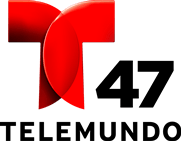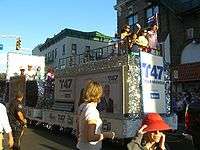WNJU
WNJU, virtual channel 47 (UHF digital channel 35), is a Telemundo owned-and-operated television station licensed to Linden, New Jersey, United States and serving the New York City television market. It is one of two East Coast flagship stations of the Spanish-language network (alongside WSCV in Miami–Fort Lauderdale, Florida). WNJU is owned by the Telemundo Station Group subsidiary of NBCUniversal (itself a subsidiary of Comcast), as part of a duopoly with New York-licensed NBC flagship WNBC (channel 4). WNJU's studios are located on Fletcher Avenue in Fort Lee, New Jersey, and it shares transmitter facilities with WNBC at One World Trade Center.
 | |
| Linden, New Jersey/ New York, New York United States | |
|---|---|
| City | Linden, New Jersey |
| Channels | Digital: 35 (UHF) (shared with WNBC) Virtual: 47 (PSIP) |
| Branding | Telemundo 47 |
| Slogan | Trabajando para ti (Working for You) |
| Programming | |
| Subchannels | See § Digital channels |
| Affiliations | 47.1: Telemundo (O&O) 47.2: TeleXitos |
| Ownership | |
| Owner | Telemundo Station Group (a subsidiary of NBCUniversal) (NBC Telemundo License LLC) |
| Sister stations | broadcast: WNBC cable: SportsNet New York |
| History | |
| First air date | May 16, 1965 (55 years ago) |
| Former call signs | WNJU-TV (1965–1988)[1][2] |
| Former channel number(s) |
|
| Former affiliations | Independent (1965–1987) NetSpan (1984–1987) |
| Call sign meaning | New Jersey UHF |
| Technical information | |
| Licensing authority | FCC |
| Facility ID | 73333 |
| ERP | 575 kW |
| HAAT | 496 m (1,627 ft) |
| Transmitter coordinates | 40°42′46.8″N 74°0′47.3″W |
| Links | |
| Public license information | Profile LMS |
| Website | www |

History
WNJU-TV signed on the air on May 16, 1965 as the first commercial UHF station in the New York television market (WNYC-TV was the first UHF station to sign on the air in 1961, but it was operated as a non-commercial educational station for its first 35 years of existence despite having a commercial license). The station originally broadcast from the Mosque Theater (now Newark Symphony Hall), located at 1020 Broad Street in Newark, in the former studios of WATV (channel 13). The station was owned by Henry Becton (son of Maxwell Becton, co-founder of Becton Dickinson) and Fairleigh S. Dickinson Jr. (son of Fairleigh S. Dickinson Sr., founder of Fairleigh Dickinson University and also the co-founder of Becton Dickinson). The general manager during WNJU's early years was pioneering UHF broadcaster Edwin Cooperstein. The station's initial schedule featured a mix of English, Asian, Spanish and Italian shows. During the mid-1960s, the station broadcast a live and locally produced teenage dance show called Disc-O-Teen, hosted by John Zacherle; and a folk music program, Rainbow Quest, hosted by Pete Seeger. WNJU was involved in some controversy when it aired bullfights, which some critics believed were too violent. The station was not profitable due to the lack of awareness of UHF stations in the New York metropolitan area. The market had seven VHF stations, six of which were commercial, at a time when most cities had an average of three commercial stations. WNJU already had two strikes against it, and served minority audiences with mostly brokered programming.
WNJU-TV was sold in the fall of 1970 for $8 million (a fairly high price for a UHF station back in 1970) to Screen Gems Broadcasting, a subsidiary of Columbia Pictures. It was thought that WNJU would now become competitive because Screen Gems had deep pockets, but the brokered ethnic format would ultimately continue. It maintained an English-speaking audience a few hours a week during the 1970s when it was the only New York broadcast outlet for the World Wide Wrestling Federation. The station used a logo with WAPA-TV's "Open 4" and the same mascot, as it was WAPA-TV's sister station and its affiliate at the time, it is recognized the precursor to today's WAPA America.
By the late 1970s, WNJU-TV had evolved into mostly Spanish programming, along with some ethnic brokered programs that aired on weekends. During the week, WNJU ran English-speaking religious programming until noon. From 12:00 p.m. onward, the station ran Spanish programming. On Sundays, the station also aired English-language religious programs in the morning. WNJU was sold in 1979 to a consortium led by Jerry Perenchio, Bud Yorkin and Norman Lear. By the early 1980s, much of the other brokered foreign language programming disappeared, with WNJU airing English language religious programming in the morning and Spanish programming the rest of the day. Some brokered programs, including Greek (and Italian in the early-mid 1970s), aired on Sunday afternoons into the early 1990s.
In 1984, WNJU-TV joined with two Spanish language television stations that were not affiliated with the Spanish International Network (now Univision) and formed NetSpan, the United States' second Spanish-language television network. NetSpan's original group of affiliates included WNJU-TV, KSTS in San Jose, California, and WBBS in Chicago (which aired its programming in the evenings and late nights only); the latter two stations were locally owned. In 1985, KVEA in Corona, California, WSCV in Fort Lauderdale, Florida (both of which were owned by Blair Broadcasting), and locally owned WCIU-TV in Chicago (which aired NetSpan programming after 5 p.m. only) joined NetSpan. The network acquired WNJU-TV and the other stations, except for WCIU, outright in 1986.

In 1987, NetSpan added more affiliates, and changed its name to Telemundo. In Chicago, WSNS-TV dropped its Univision affiliation and joined Telemundo, with WCIU carrying Univision programming after 5 p.m. In the early 1990s, WNJU dropped its English-language religious shows and became a full-time Telemundo station.
In 1989, the station moved its operations to 39 Industrial Avenue in Teterboro. In 2001, General Electric (then-owner of NBC) purchased Telemundo. WNJU witnessed major overhauls, adopting similar opening graphics to those used at New York City's WNBC, and adopting a tweaked version of its opening music sequence. In 2003, WNJU relocated to the Sixth Floor at 2200 Fletcher Avenue in Fort Lee, occupying the former studios and offices of the NBC-owned CNBC cable network, which around the same time moved to a state-of-the-art new studio complex at 900 Sylvan Avenue (Route 9W) in Englewood Cliffs.
In 2009, WNJU debuted the morning magazine program Las Comadres con Gloria B, which became the No. 1 program in the market in its timeslot, garnering 1.5 million viewers.[3]
On May 17, 2017, WNJU announced it would begin over-the-air nighttime transmission testing from One World Trade Center in the fourth week of May 2017, which they expected to commence seven to 10 days later, and by the end of the year, WNJU and four other NYC area TV stations began broadcasting from the new tower.[4][5]
Digital television
Digital channels
The station's digital signal is multiplexed:
| Channel | Video | Aspect | PSIP Short Name | Programming[6] |
|---|---|---|---|---|
| 47.1 | 1080i | 16:9 | WNJU-HD | Main WNJU programming / Telemundo |
| 47.2 | 480i | 4:3 | TeleX | TeleXitos |
On November 1, 2011, WNJU began broadcasting the soi network on digital subchannel 47.3. A month later, WNJU began broadcasting the Telemundo 2 Network on digital channel 47.2. WNJU also operates a Mobile DTV feed of subchannel 47.1, labelled "WNJU T47".
As of November 2014, WNJU has replaced EXITOS with TeleXitos on 47.2 and soi is no longer on 47.3.
Analog-to-digital conversion
WNJU discontinued regular programming on its analog signal, over UHF channel 47, on June 12, 2009, as part of the federally mandated transition from analog to digital television.[7] The station's digital signal remained on its pre-transition UHF channel 36,[8] using PSIP to display WNJU's virtual channel as 47 on digital television receivers.
On April 13, 2017, it was revealed that the over-the-air spectrum of sister station WNBC had been sold in the FCC's spectrum reallocation auction, fetching $214 million. WNBC will remain in operation, sharing broadcast spectrum with WNJU.[9] The shared broadcast took effect April 2, 2018.[10] WNJU along with WNBC later changed channels again to digital channel 35 on August 1, 2019 at 1 PM local time.[11]
News operation
WNJU presently broadcasts 17 hours of locally produced newscasts each week (with three hours each weekday and one hour each on Saturdays and Sundays); in addition, the station produces a newsmagazine program titled Acceso Total, which airs weekday mornings at 10 a.m. and the public affairs program Enfoque New York (a local version of the Telemundo discussion program Enfoque), which airs Sundays at noon.
WNJU launched its news operation in the late 1980s, with 6 p.m. and 11 p.m. newscasts anchored by Jorge L. Ramos In 1997, it launched a weekend edition of Noticiero 47, anchored by Ivan Taylor. In 2001, it launched a morning newscast called Noticiero 47 Primera Edicion, as well as a midday newscast, and the weekend newscast was taken over by Ramon Zayas. However, due to company-wide cutbacks, WNJU pulled the plug on its morning, midday, and weekend newscasts in 2009.
Three years later, in 2012, the weekend newscast was relaunched, and in November 2012, a new morning newscast was introduced, called Buenos días, Nueva York. Buenos Días expanded to 5 a.m., adding El Pacha from rival WXTV-DT, though it later reverted to its former title of Noticiero 47 Primera Edicion. Gloria Echeverry was also added to the weeknight newscasts as co-anchor, while Yaima Crespo joined the weekend newscasts in that same capacity. Entertainment reporter Odalys Molina was moved to the morning newscast. During that time, the station also received a new helicopter, HelicopteroT47, along with sister station WNBC and rival WXTV-DT. Morning weather anchor Audris Rijo and Rafael Bello now anchor Acceso Total.
On September 18, 2014, Telemundo announced a new 5:30 p.m./4:30 p.m. newscast for all 14 of its owned-and-operated stations, including WNJU. Additionally, a new daytime newscast debuted November 3, 2014.
Notable on-air staff
Current
- Audris Rijo – on Acceso Total
Former
- John F. Bateman – host, Rutgers Football Highlights[12]
- Brook Benton – host, The Brook Benton Show[13]
- Buck Canel – anchor, Spanish News and Sports[12]
- Myer Feldman – host, Jewish Issues[12]
- Hal Jackson – host, World of Entertainment[12]
- Helen Meyner – Helen Meyner Program[12]
- Jorge L. Ramos – anchor
- Jackie Robinson – host, A Time to Talk[13]
- Billy Taylor – host, Jazz in America[14]
- Richard Voliva – host, High School Wrestling[12]
- Zacherley – host, Disco-Teen[12]
References
- F.C.C.'s history cards for WNJU; retrieved January 17, 2019.
- Callsign history for WNJU; retrieved January 17, 2019.
- Steel, Pigeon. "Show las Comadres with Gloria B". Archived from the original on December 2, 2013. Retrieved November 15, 2009.
- Kurz, Phil (May 18, 2017). "WNJU To Kick Off 1 WTC OTA Transmission". TVNewsCheck. NetNewsCheck Media, LLC. Retrieved May 23, 2017.
- Marszalek, Diana (June 26, 2017). "WNJU New York Brings Broadcasting Back to World Trade Center". Radio World. Retrieved June 27, 2017.
- RabbitEars TV Query for WNJU
- List of Digital Full-Power Stations
- CDBS Print
- "NBC Makes Over $480 Million From Auction". TVNewsCheck. Retrieved 13 April 2017.
- "How to Rescan Your Television to Receive NBC New York's Signal". WNBC. Retrieved May 3, 2018.
- "The New World of TV Entertainment on New Channel 47 atop Empire State Building". N. Y. Amsterdam News. April 3, 1965. Retrieved August 13, 2019.
- "WNJU-TV Sets New Shows and Personalities". Back Stage. May 7, 1965. Retrieved August 13, 2019.
- "Channel 47 Debuts Its 'Double Exposure'". N. Y. Amsterdam News. June 26, 1965. Retrieved August 13, 2019.
External links
- WNJU Website
- Telemundo Website
- TeleXitos Website
- The WNJU-TV History Web-Site
- WNJU in the FCC's TV station database